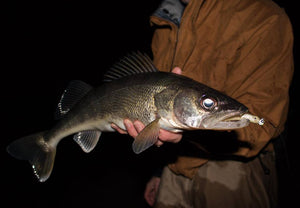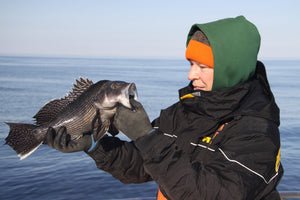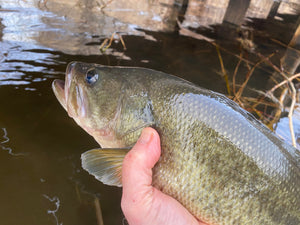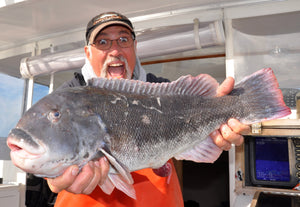Late Fall Blackfishing

Blackfishing is one of those intangible lines that separate the wanna-bes from the real fishing experts. Learn to catch blackfish consistently and you can learn to catch any other fish in the sea. Show off a couple of bulldogs, as the biggest blackfish are known, and nobody will question your angling ability. The words “luck” and “blackfishing” are rarely used together while “skill” and “blackfishing” are frequently linked.
Big blackfish love green crabs. To attract bulldogs and discourage smaller ‘tog from biting, try using a whole “greenie” – or a small Jonah crab – around slack tide when dropping deep November and December. Photo by OutdoorTom.com.
Most anglers are aware that blackfish love to hang around underwater obstructions and rocky bottom, but they frequently fail to consider that “tautog” or “’tog,” as New Englanders call this member of the wrasse family, also require that the water range between 50 and 60 degrees. To stay in this range the fish move inshore and off throughout the season, coming to the shallows in spring and fall and holding deep during summer and winter. On Long Island, the inshore fall run peaks in late October and early November while deeper action continues in the ocean and Long Island Sound until the fall blackfish season closes in December. Be sure to check the most recent NYS saltwater regulations for seasons and possession limits as the Long Island Sound blackfish restrictions are different from those for other parts of Long Island.
Blackfish relish snag-infested “live” bottom that hosts an abundance of crabs, mussels and baby lobster. When the tide is slack, the tog hide within crevices, holes, depressions and cut-outs. As the tide begins to push, they take up feeding positions at the head and along the lead outside edges, scoffing up tasty morsels like green or calico crabs that get caught in the current and tumble past. At the height of the tide, the chunky-shaped blacks tuck inside or behind structure to get out of the current, returning to their feeding stations as the tide relents later in the day - thus their reputation for feeding at the start and end of a tide, when currents are generally mild to moderate.
Since the blacks rarely wander more than a few yards from structure during their feeding forays, it is vital to anchor-up so that your baits will touch down within a few feet of a boulder, wreck, mussel hump, bridge abutment or whatever is holding the fish. For this reason, experienced blackfishermen usually double-anchor their boats from the bow and ease back until they are almost directly over a selected piece of bottom. As a rule, the biggest blacks prefer the nastiest, snag-infested real estate, so if you aren’t losing some tackle, you aren’t fishing in the right place.
When it comes to tackle, a six- to seven-foot, medium action rod and sturdy conventional reel should get the job done for most inshore scenarios. It’s important, however, that your reel be spooled with a quality line that features a relatively short top-shot of abrasion resistant leader since ‘tog live in such rough environs. Depending on how deep you fish and how strong the current, you can target these fish with lines as light as 12-pound test or as heavy as 30-pound test. The rule is to use the lightest sinker that will let you hold bottom. With late fall action generally in deep water of 50 to 80 feet, braided lines have a decided the edge over monofilament options.

Be sure to dress for the weather when heading out on late-season blackfish trips. Cold and sunless days with a drizzle often produce great action. Photo by OutdoorTom.com.
Because you’ll generally be fishing deep for blackfish come November and December, a standard bottom rig holds an edge over blackfish jigs when it comes to the terminal end. Sure, the sharpies can jig blackfish in 60 to 80 feet or more of water, but most anglers will feel the bottom better and sense strikes easier with a more traditional setup. To that end, go with a single-hook rig featuring a 30-inch leader of 30- to 40-pound-test fluorocarbon tied to a black barrel swivel at the end of the main line, then add an end loop to hold a bank sinker. Next, tie in a 4/0 Gamakatsu Octopus or Owner SSW hook via a dropper loop six to eight inches above the sinker. Finally, add a simple over-hand knot two inches above the sinker. This weakens the line so that, if the sinker gets stuck on the bottom, you can break off without losing your hook - or a trophy black that has gotten your sinker snagged.
Finding blackfish and getting bait to fall right in front of them is only half the battle, setting the hook and hauling ‘em up is the other. The hook-setting seems to be especially frustrating to novice anglers and with good reason. Blackfish, you see, sport two sets of teeth: a pair of buck teeth just behind the lips used for picking meals from their perch, and a molar-like set used to crack and grind the shells of crabs and mussels.
When a blackfish picks up a bait, the item is held by the front teeth for a moment, then sent back to be pulverized by the second set. Try to set the hook on the first tap and you’ll pull the bait away. Not until the bait is passed back can the point be firmly set. Wait too long, however, and the hook is expelled with the crushed crab sell. It’s a timing thing, hooking blackfish, something that requires practice to get the knack. Keeping a finger to your line to feel the difference between the pick-up and the swallow will help you learn when to make your move.
Although blackfish will scoff up clam and worm baits, crabs are a better choice as they seem to limit the number of attacks from pesky bergalls. For deep water, late fall ‘togging, green crabs draw plenty of bites and hold up better on the hook than fiddlers, hermits or Asian crabs. As the water gets colder toward the end of the season, white crabs (Jonah crabs) also catch a lot of ‘tog as well.
Using green or white crabs requires a bit of work. Those with shells smaller than silver dollar can be offered whole. To rig these, cut off the legs (with a pair of scissors) on one side and insert the hook though one leg socket and out another so the point is fully exposed. Leave the legs on the opposite side.
Nothing beats a pile of fillets gathered with friends at the end of a hard day’s work targeting deep water ‘tog. Photo by OutdoorTom.com.
Larger green crabs should be split in half or even quartered. Remove the top shell and split the crab from front to back. If it's a really large crab, divide each section in half again. Now, remove the legs and claws and insert the hook though one exposed leg socked and out another. Again, be sure the hook point protrudes fully.
No matter where you catch them, blackfish action seems to peak on the first two or last two hours of moving water. Don’t pass up the slack tide period, however, as that’s when the real monsters often come out to play.
- Bryce Poyer








